Abstract
Until very recently, rabies research had made few notable advances since the time of Pasteur, but during the past few years the use of modern virological techniques has led to rapid progress in research on the rabies virus. This article summarizes the present state of knowledge of pathogenesis, immunology, cultivation in tissue culture, cell—virus relationships, and physicochemical properties of the virus.
It is now possible, and opportune, to undertake the study of basic problems in the biology of rabies, which include the need for an improved method of post-exposure protection. Information gained from work on these problems should lead to important insights into other current problems of infectious processes such as “slow-virus” infections. The most promising directions of future research in rabies are enumerated and suggestions are made on the experimental techniques that might be used for such studies.
Full text
PDF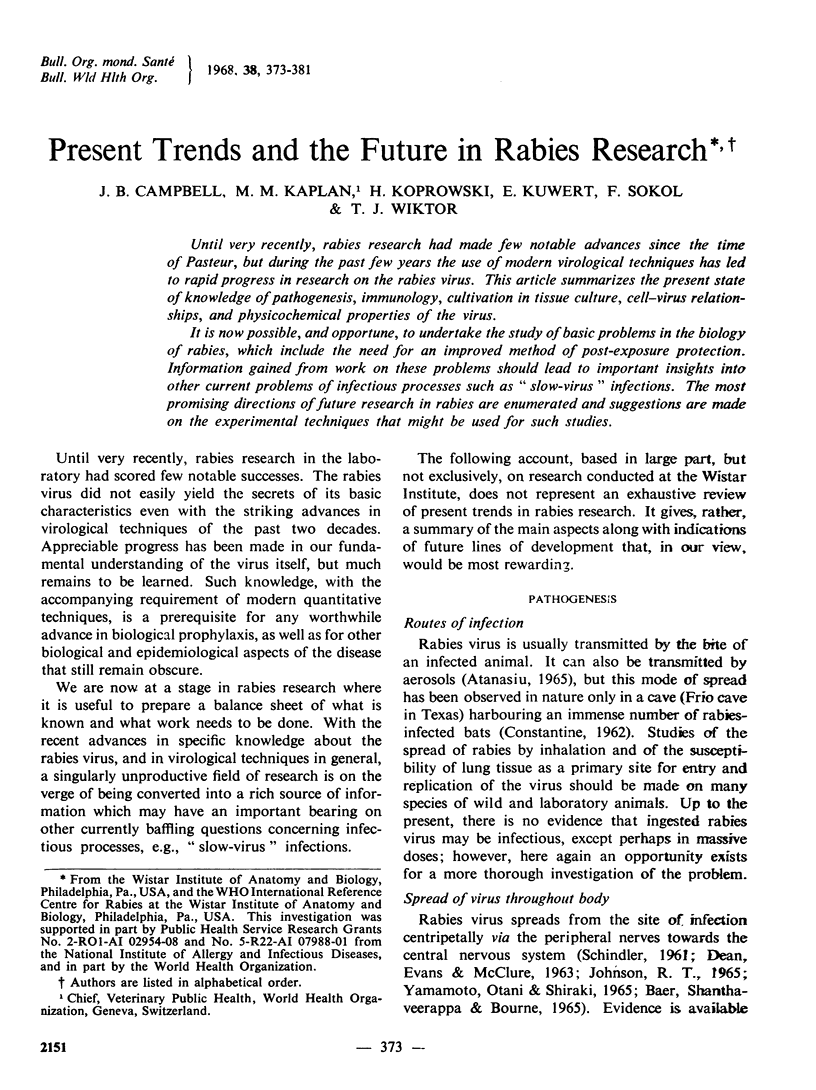
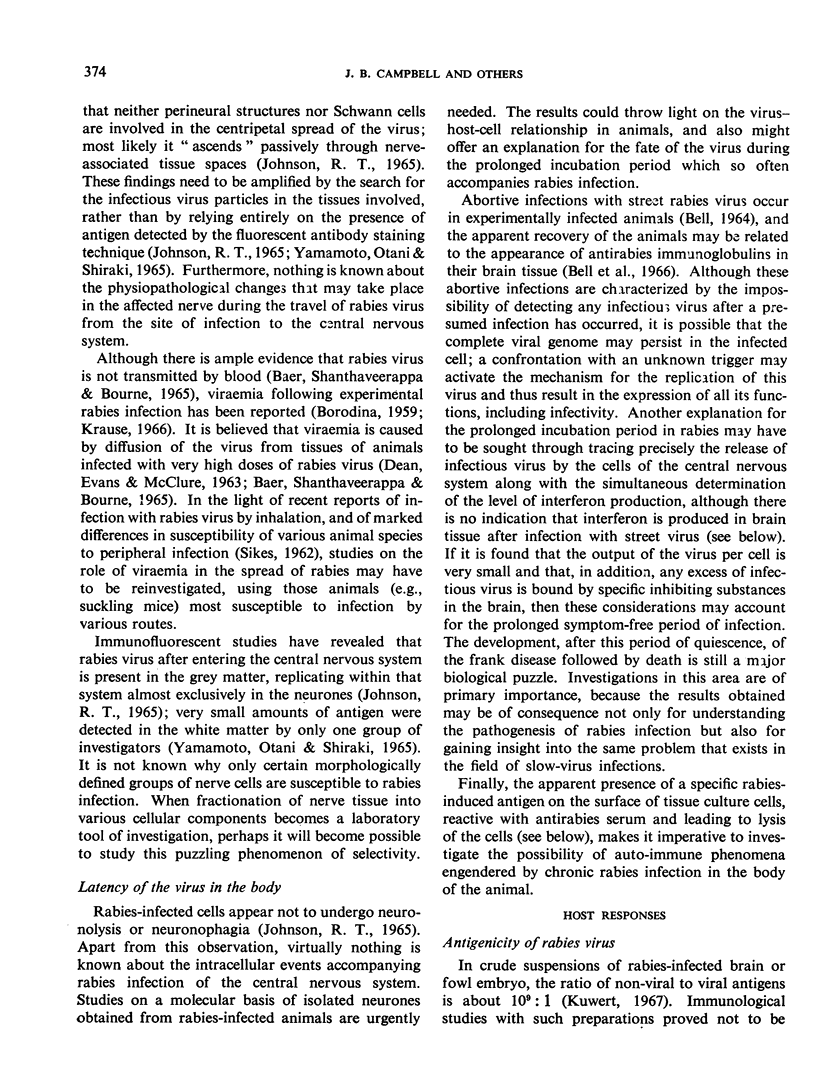
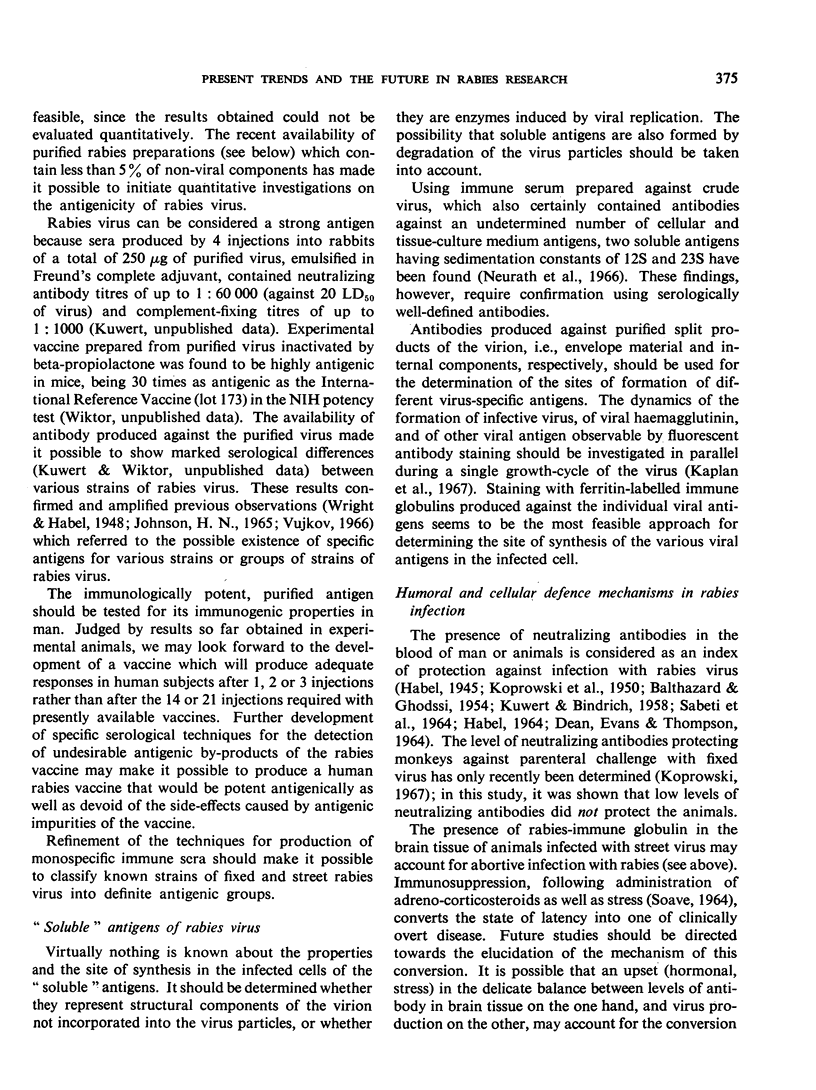
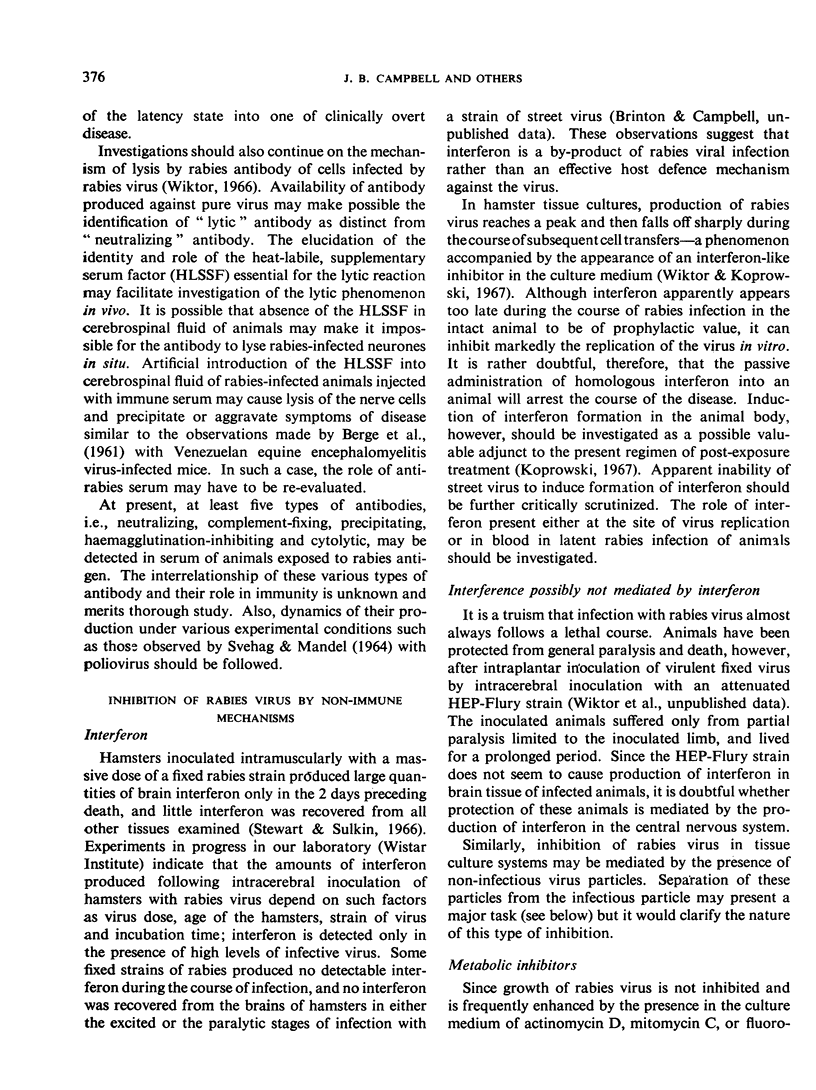
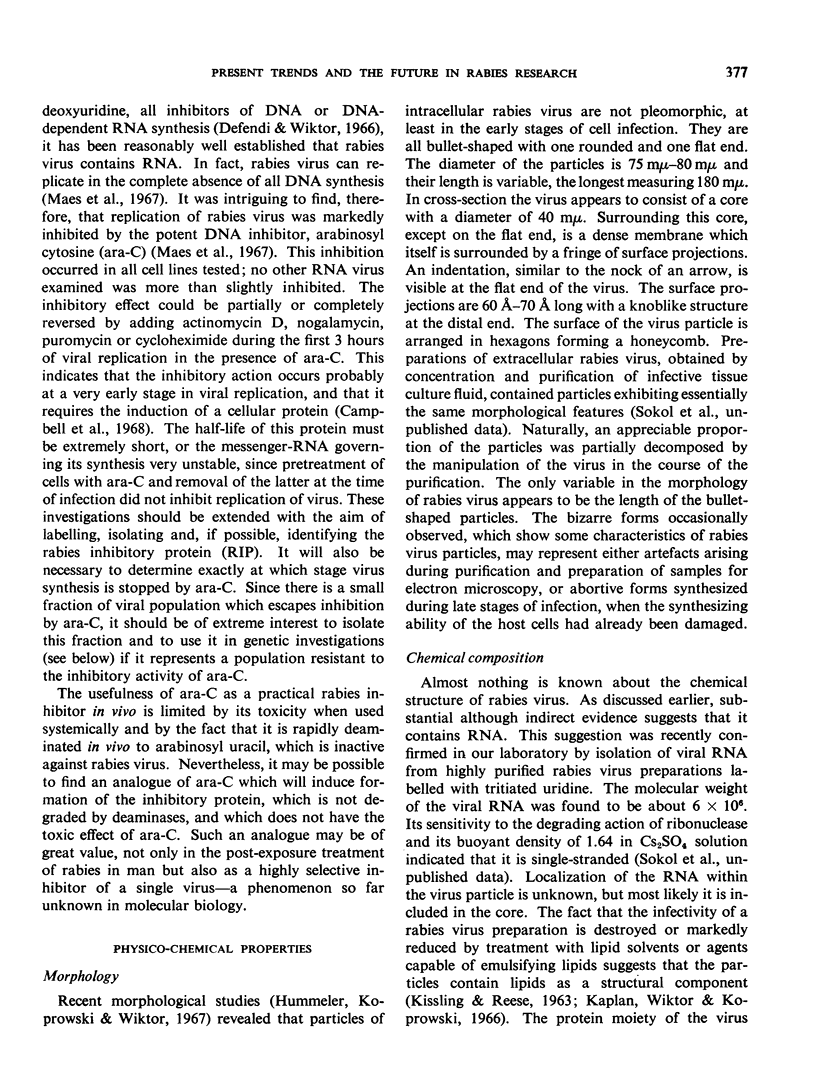
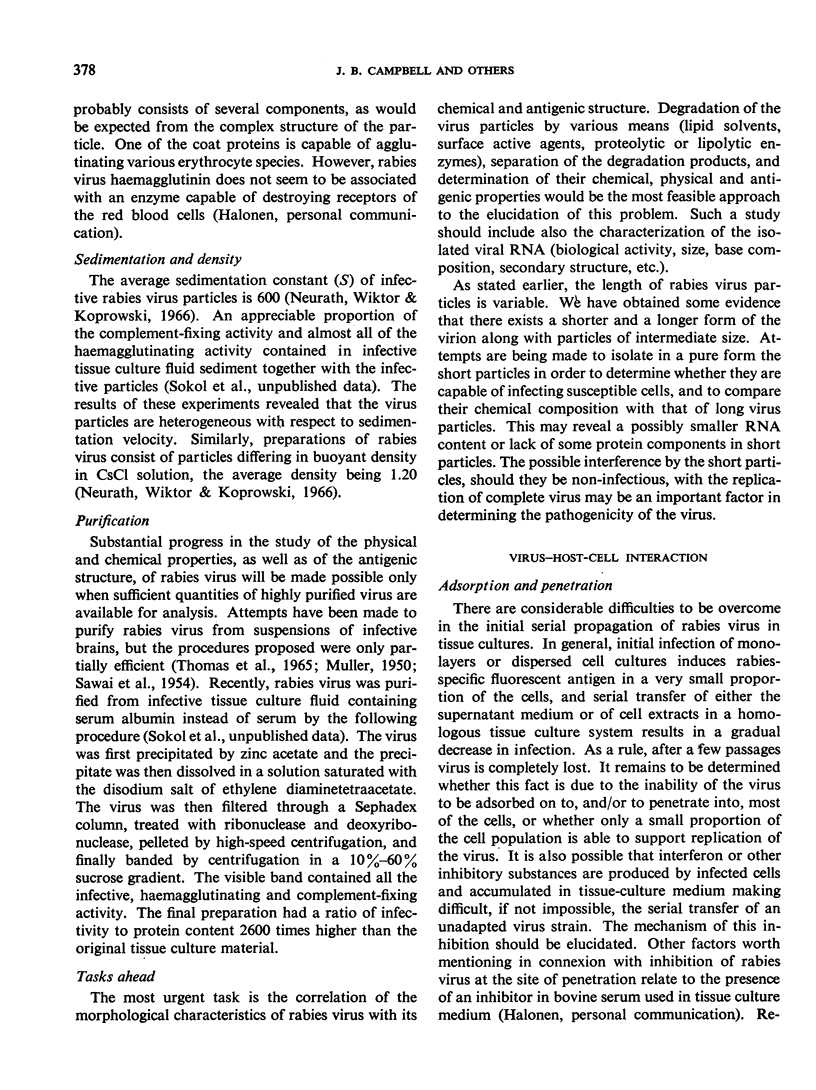
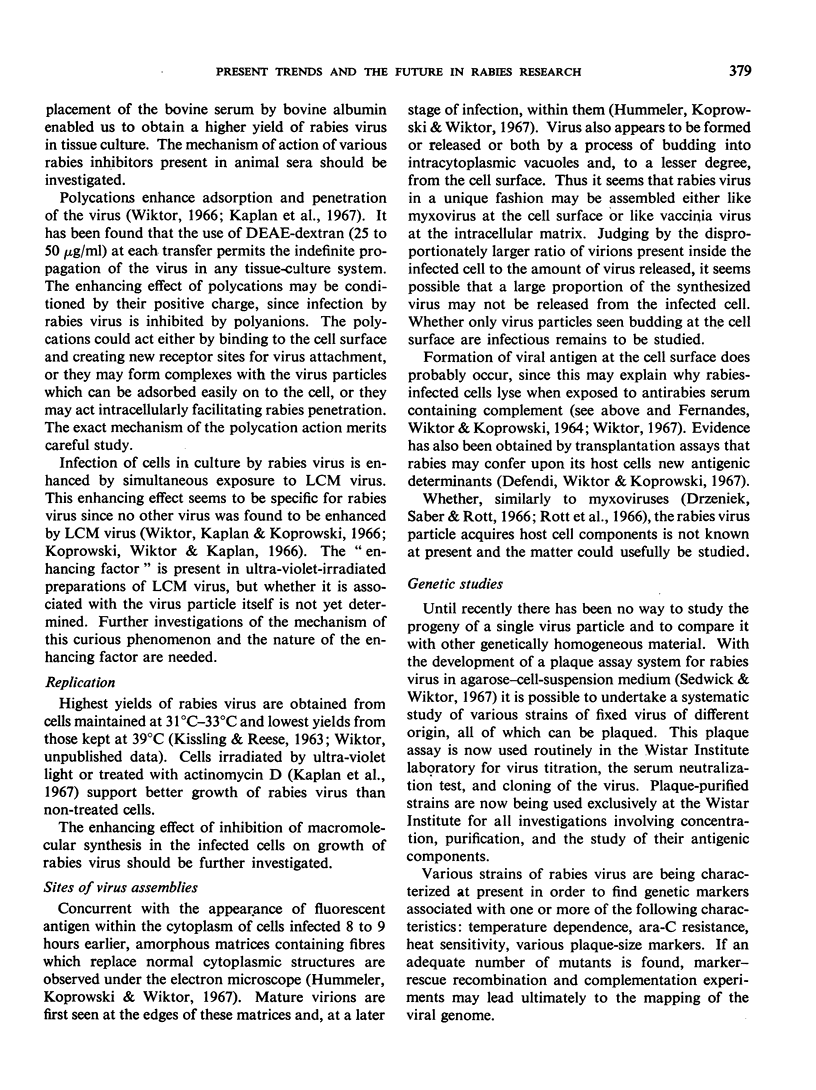
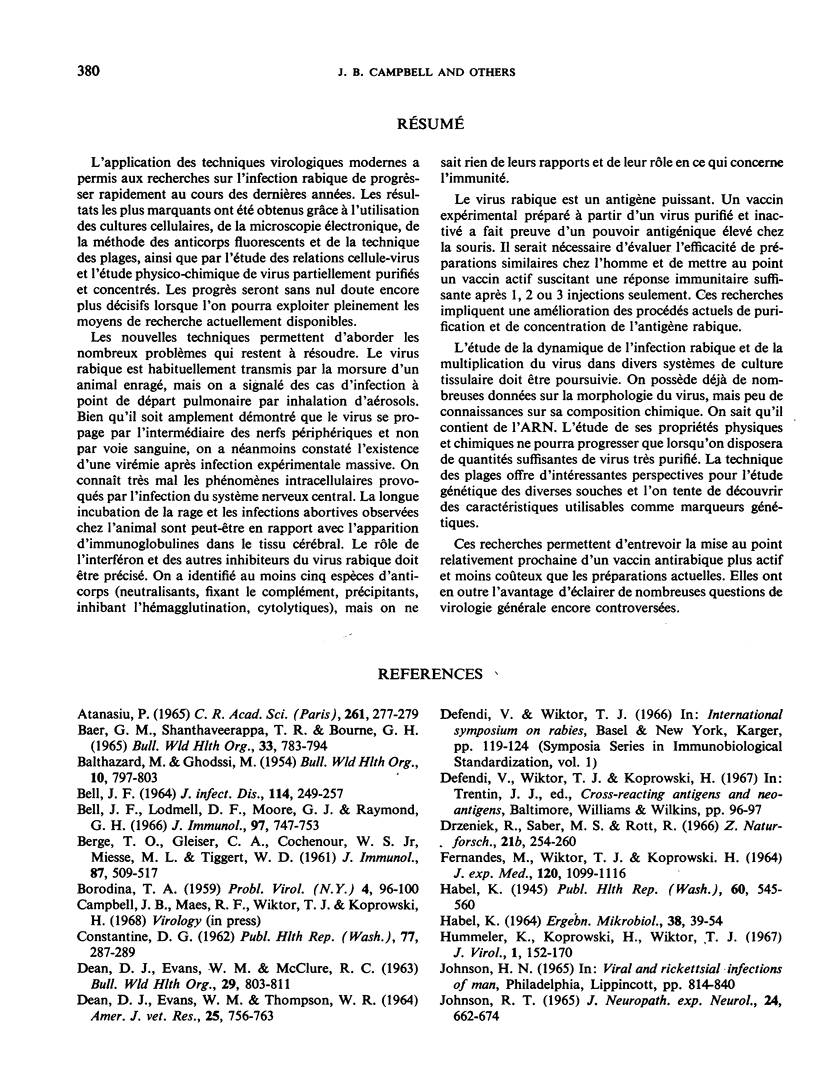
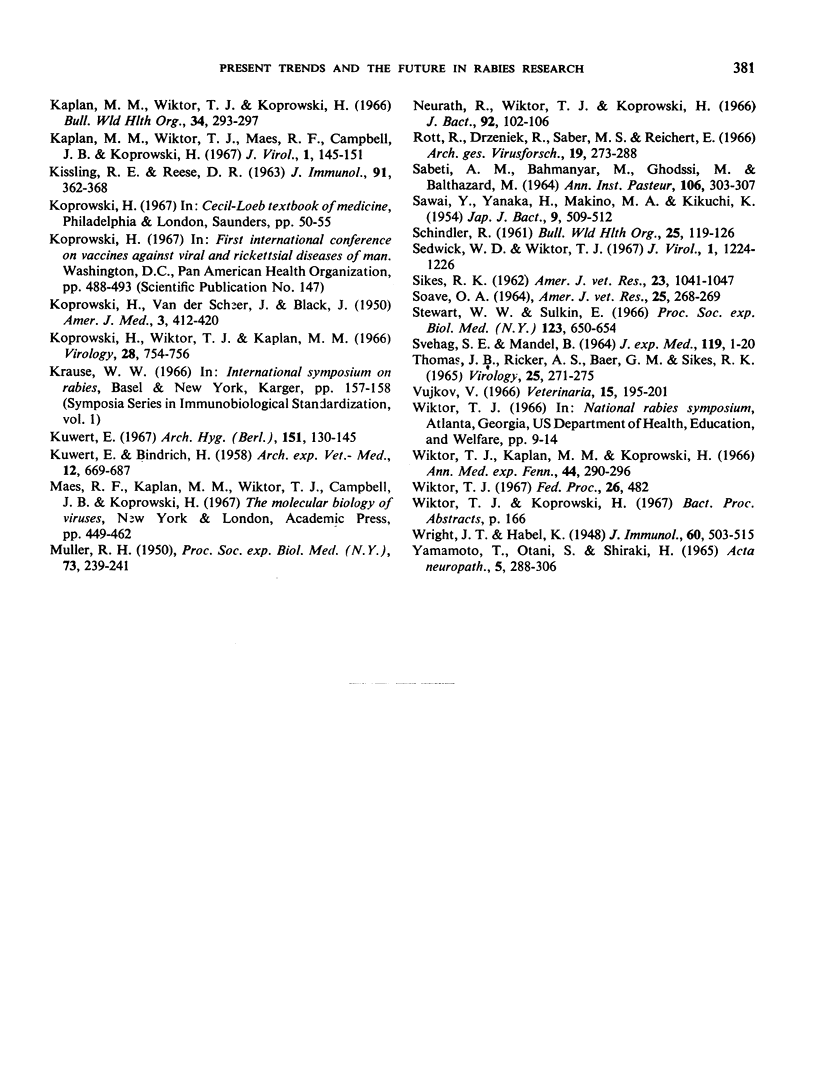
Selected References
These references are in PubMed. This may not be the complete list of references from this article.
- Atanasiu P. Transmission de la rage par la voie respiratoire aux animaux de laboratoire. C R Acad Sci Hebd Seances Acad Sci D. 1965 Jul 5;261(1):277–279. [PubMed] [Google Scholar]
- BALTAZARD M., GHODSSI M. Prevention of human rabies; treatment of persons bitten by rabid wolves in Iran. Bull World Health Organ. 1954;10(5):797–803. [PMC free article] [PubMed] [Google Scholar]
- BELL J. F. ABORTIVE RABIES INFECTION. I. EXPERIMENTAL PRODUCTION IN WHITE MICE AND GENERAL DISCUSSION. J Infect Dis. 1964 Jun;114:249–257. doi: 10.1093/infdis/114.3.249. [DOI] [PubMed] [Google Scholar]
- BERGE T. O., GLEISER C. A., GOCHENOUR W. S., Jr, MIESSE M. L., TIGERTT W. D. Studies on the virus of Venezuelan equine encephalomyelitis. II. Modification by specific immune serum of response of central nervous system of mice. J Immunol. 1961 Nov;87:509–517. [PubMed] [Google Scholar]
- Baer G. M., Shanthaveerappa T. R., Bourne G. H. Studies on the pathogenesis of fixed rabies virus in rats. Bull World Health Organ. 1965;33(6):783–794. [PMC free article] [PubMed] [Google Scholar]
- Bell J. F., Lodmell D. L., Moore G. J., Raymond G. H. Brain neutralization of rabies virus to distinguish recovered animals from previously vaccinated animals. J Immunol. 1966 Dec;97(6):747–753. [PubMed] [Google Scholar]
- CONSTANTINE D. G. Rabies transmission by nonbite route. Public Health Rep. 1962 Apr;77:287–289. [PMC free article] [PubMed] [Google Scholar]
- DEAN D. J., EVANS W. M., MCCLURE R. C. PATHOGENESIS OF RABIES. Bull World Health Organ. 1963;29:803–811. [PMC free article] [PubMed] [Google Scholar]
- DEAN D. J., EVANS W. M., THOMPSON W. R. STUDIES ON THE LOW EGG PASSAGE FLURY STRAIN OF MODIFIED LIVE RABIES VIRUS PRODUCED IN EMBRYONATING CHICKEN EGGS AND TISSUE CULTURE. Am J Vet Res. 1964 May;25:756–763. [PubMed] [Google Scholar]
- Drzeniek R., Reichert E., Rott R. Extraktion wirtsspezifischer Bestandteile des Newcastle disease Virus (NDV) Zentralbl Veterinarmed B. 1966 Jun;13(3):260–262. [PubMed] [Google Scholar]
- FERNANDES M. V., WIKTOR T. J., KOPROWSKI H. ENDOSYMBIOTIC RELATIONSHIP BETWEEN ANIMAL VIRUSES AND HOST CELLS. A STUDY OF RABIES VIRUS IN TISSUE CULTURE. J Exp Med. 1964 Dec 1;120:1099–1116. doi: 10.1084/jem.120.6.1099. [DOI] [PMC free article] [PubMed] [Google Scholar]
- HABEL K. ADVANCES IN RABIES RESEARCH. Ergeb Mikrobiol Immunitatsforsch Exp Ther. 1964;38:39–54. doi: 10.1007/978-3-662-42622-7_2. [DOI] [PubMed] [Google Scholar]
- Hummeler K., Koprowski H., Wiktor T. J. Structure and development of rabies virus in tissue culture. J Virol. 1967 Feb;1(1):152–170. doi: 10.1128/jvi.1.1.152-170.1967. [DOI] [PMC free article] [PubMed] [Google Scholar]
- Johnson R. T. Experimental rabies. Studies of cellular vulnerability and pathogenesis using fluorescent antibody staining. J Neuropathol Exp Neurol. 1965 Oct;24(4):662–674. [PubMed] [Google Scholar]
- KISSLING R. E., REESE D. R. ANTI-RABIES VACCINE OF TISSUE CULTURE ORIGIN. J Immunol. 1963 Sep;91:362–368. [PubMed] [Google Scholar]
- KOPROWSKI H., VAN DER SCHEER J., BLACK J. Use of hyperimmune anti-rabies serum concentrates in experimental rabies. Am J Med. 1950 Apr;8(4):412–420. doi: 10.1016/0002-9343(50)90224-5. [DOI] [PubMed] [Google Scholar]
- Kaplan M. M., Wiktor T. J., Maes R. F., Campbell J. B., Koprowski H. Effect of polyions on the infectivity of rabies virus in tissue culture: construction of a single-cycle growth curve. J Virol. 1967 Feb;1(1):145–151. doi: 10.1128/jvi.1.1.145-151.1967. [DOI] [PMC free article] [PubMed] [Google Scholar]
- Kaplan M. M., Wiktor T., Koprowski H. An intracerebral assay procedure in mice for chemical inactivation of rabies virus. Bull World Health Organ. 1966;34(2):293–297. [PMC free article] [PubMed] [Google Scholar]
- Koprowski H., Wiktor T. J., Kaplan M. M. Enhancement of rabies virus infection by lymphocytic choriomeningitis virus. Virology. 1966 Apr;28(4):754–756. doi: 10.1016/0042-6822(66)90260-1. [DOI] [PubMed] [Google Scholar]
- Kuwert E. Versuche zur Antigenität, Schutzkraft und Encephalitogenität der Hempt-Vaccine sowie Betrachtungen zur Tollwutschutzimpfung in Deutschland. Arch Hyg Bakteriol. 1967 May;151(1):130–145. [PubMed] [Google Scholar]
- Neurath A. R., Wiktor T. J., Koprowski H. Density gradient centrifugation studies on rabies virus. J Bacteriol. 1966 Jul;92(1):102–106. doi: 10.1128/jb.92.1.102-106.1966. [DOI] [PMC free article] [PubMed] [Google Scholar]
- SABETI A., BAHMANYAR M., GHODSSI M., BALTAZARD M. TRAITEMENT DES MORDUS PAR LOUPS ENRAG'ES EN IRAN. SITUATION ACTUELLE. Ann Inst Pasteur (Paris) 1964 Feb;106:303–307. [PubMed] [Google Scholar]
- SCHINDLER R. Studies on the pathogenesis of rabies. Bull World Health Organ. 1961;25:119–126. [PMC free article] [PubMed] [Google Scholar]
- SIKES R. K. Pathogenesis of rabies in wildlife. I. Comparative effect of varying doses of rabies virus inoculated into foxes and skunks. Am J Vet Res. 1962 Sep;23:1041–1047. [PubMed] [Google Scholar]
- SOAVE O. A. REACTIVATION OF RABIES VIRUS IN A GUINEA PIG DUE TO THE STRESS OF CROWDING. Am J Vet Res. 1964 Jan;25:268–269. [PubMed] [Google Scholar]
- SVEHAG S. E., MANDEL B. THE FORMATION AND PROPERTIES OF POLIOVIRUS-NEUTRALIZING ANTIBODY. I. 19S AND 7S ANTIBODY FORMATION: DIFFERENCES IN KINETICS AND ANTIGEN DOSE REQUIREMENT FOR INDUCTION. J Exp Med. 1964 Jan 1;119:1–19. doi: 10.1084/jem.119.1.1. [DOI] [PMC free article] [PubMed] [Google Scholar]
- Sedwick W. D., Wiktor T. J. Reproducible plaquing system for rabies, lymphocytic choriomeningitis,k and other ribonucleic acid viruses in BHK-21-13S agarose suspensions. J Virol. 1967 Dec;1(6):1224–1226. doi: 10.1128/jvi.1.6.1224-1226.1967. [DOI] [PMC free article] [PubMed] [Google Scholar]
- Stewart W. E., 2nd, Sulkin S. E. Interferon production in hamsters experimentally infected with rabies virus. Proc Soc Exp Biol Med. 1966 Dec;123(3):650–654. doi: 10.3181/00379727-123-31568. [DOI] [PubMed] [Google Scholar]
- THOMAS J. B., RICKER A. S., BAER G. M., SIKES R. K. PURIFICATION OF FIXED RABIES VIRUS. Virology. 1965 Feb;25:271–275. doi: 10.1016/0042-6822(65)90205-9. [DOI] [PubMed] [Google Scholar]
- WRIGHT J. T., HABEL K. A comparison of antigenicity and certain biological characteristics of six substrains of Pasteur fixed rabies virus. J Immunol. 1948 Dec;60(4):503–515. [PubMed] [Google Scholar]
- Wiktor T. J., Kaplan M. M., Koprowski H. Rabies and lymphocytic choriomeningitis virus (LCMV) infection of tissue culture; enhancing effect of LCMV. Ann Med Exp Biol Fenn. 1966;44(2):290–296. [PubMed] [Google Scholar]
- Yamamoto T., Otani S., Shiraki H. A study of the evolution of viral infection in experimental herpes simplex encephalitis and rabies by means of fluorescent antibody. Acta Neuropathol. 1965 Nov 18;5(2):288–306. doi: 10.1007/BF00686524. [DOI] [PubMed] [Google Scholar]


